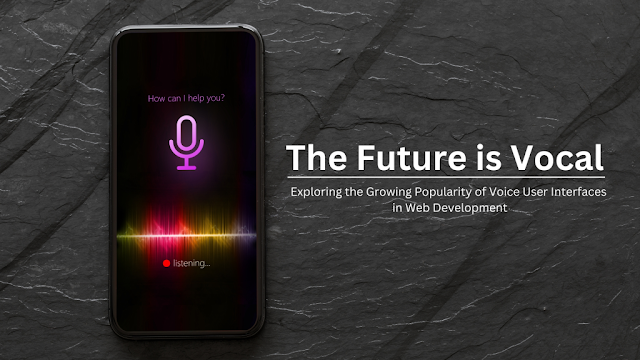The Future is Vocal: Exploring the Growing Popularity of Voice User Interfaces in Web Development
In this blog post, we’ll delve into the exciting world of VUIs and explore why they are becoming increasingly popular in web development. So sit back, relax, and get ready to witness how the future is truly vocal!
What is Voice User Interface (VUI) Technology?
Voice user interface (VUI) technology is a type of artificial intelligence that enables humans to interact with computers using natural language spoken commands. VUI-enabled devices are able to understand and respond to human speech, making them an increasingly popular choice for many common tasks such as online search, navigation, and information retrieval.
The popularity of VUIs can be attributed to several factors, including the continued rise of smart speakers and other voice-activated devices, the increasing accuracy of speech recognition technology, and the growing trend of hands-free computing. In addition, VUIs offer many benefits over traditional graphical user interfaces (GUIs), including increased efficiency, lower error rates, and improved accessibility for users with disabilities.
As VUI technology continues to evolve, we can expect to see more widespread adoption across a variety of industries. Some of the most likely applications for VUIs in the future include customer service chatbots, interactive voice response (IVR) systems, and automobiles equipped with voice-activated controls.
Benefits of VUI for Web Development
There are many benefits to using voice user interfaces (VUI) in web development. Perhaps the most obvious benefit is that VUIs can provide a more natural and efficient way for users to interact with websites and web applications. Studies have shown that people can speak up to three times faster than they can type, so using a VUI can potentially help users get through tasks more quickly. Additionally, VUIs can be beneficial for users with disabilities or who are otherwise unable to use a traditional graphical user interface (GUI).
Another big benefit of VUIs is that they can enable hands-free interaction with websites and web apps. This is especially useful in situations where it would be impractical or unsafe to use one’s hands, such as while driving or cooking. Additionally, hands-free interaction can be helpful for users who are physically unable to use a keyboard or mouse.
VUIs can improve the overall user experience by making it more engaging and interactive. For example, some voice assistants allow users to control website content with their voice, which can make browsing the web feel more like a conversation than a series of clicks and taps. Additionally, VUIs can add a personal touch to the user experience by customizing responses based on individual user preferences and interactions.

Popular Use Cases of VUIs in Web Development
One of the most popular use cases for VUIs in web development is creating voice-based assistants. These assistants can perform a variety of tasks, such as setting alarms, adding items to a shopping list, and checking the weather.
Another popular use case for VUIs is creating voice-activated chatbots. Chatbots are computer programs that simulate human conversation. They can be used to answer questions, provide customer support, and even sell products.
VUIs can also be used to create accessibility features for websites and apps. For example, VUIs can be used to create text-to-speech capabilities or to control a website or app with voice commands.
VUIs can be used for research purposes. For example, VUIs can be used to conduct surveys or gather data about how people interact with websites and apps.
Challenges of Using VUIs in Web Development
Voice user interfaces (VUIs) are becoming increasingly popular in web development. However, there are still some challenges associated with using VUIs. One challenge is that VUIs can be difficult to create for international audiences. This is because different languages have different phonemes (sounds), and it can be difficult to create a VUI that works well for all languages. Another challenge is that VUIs can be difficult to use for people with disabilities, such as those who are deaf or hard of hearing. This is because VUIs rely on spoken language, which can be difficult or impossible for some people to access. VUIs can be challenging to use in noisy environments, such as busy offices or public places. This is because the speech recognition technology that powers VUIs can struggle to understand speech in noisy environments.
Technologies Used to Develop VUIs
There are many different technologies that can be used to develop voice user interfaces (VUIs). Some of the most popular ones include:
–Text-to-speech (TTS) synthesis: This technology converts written text into spoken words. It can be used to create natural-sounding voices for VUIs.
–Speech recognition: This technology converts spoken words into written text. It can be used to create VUIs that can understand and respond to human speech.
–Natural language processing (NLP): This technology analyzes and interprets human language. It can be used to create VUIs that can understand and respond to human conversation.
Implementing Voice User Interfaces in Web Development
To integrate VUIs effectively into web development, consider the following best practices:
Design for Voice: Develop a user-centric approach by focusing on voice-first design principles. Consider the unique constraints and capabilities of voice interactions when designing the user interface. Ensure your design accounts for context, error handling, and providing clear feedback through voice responses.
Optimize Speech Recognition: Leverage advancements in speech recognition technology to improve accuracy and responsiveness. Test and fine-tune your VUI system to handle diverse accents, languages, and speech patterns. Implement mechanisms to handle misinterpretations and provide alternative prompts when necessary.
Contextual Understanding: Enable your VUI to understand the user’s intent within the context of the conversation. Natural language understanding (NLU) techniques, combined with machine learning algorithms, can help your system grasp user queries accurately. Utilize context to provide more relevant responses and personalized experiences.
Usability Testing and Iteration: Regularly test and refine your VUI to ensure optimal performance and user satisfaction. Collect user feedback, monitor usage patterns, and conduct usability testing to identify areas for improvement. Iterate on your VUI system based on user insights to enhance its overall effectiveness.
Conclusion
Voice User Interfaces, or VUIs, are quickly becoming a popular choice in web development. They offer an easier and more natural way for users to interact with websites and can help reduce the number of steps it takes to complete tasks. As technology continues to evolve and become more sophisticated, we can expect that VUIs will continue to grow in popularity as they become even easier for users to navigate. With its growing popularity, the future looks very bright for Voice User Interfaces!


Comments
Post a Comment